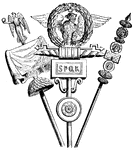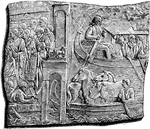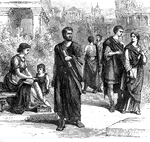This ClipArt gallery offers 396 images of the Roman Empire including culture, people, everyday life, coats of arms, and more. See also the Roman Coins, Roman Architecture, Roman Ornament, Roman Mythology, and Ancient Roman Musical Instruments ClipArt galleries.

Roman Bowl - Gaulish Samian Ware or Terra Sigillata
Illustration of a Roman bowl found in Pompeii and made by the Gauls. It is an example of what is referred…

Roman Boy
"The two chief avenues that were open to advancement were the political and the military. He must be…

Roman Eagle
"Eagle, as a military standard, was adopted by the Romans, and even by nations preceding them in history.…
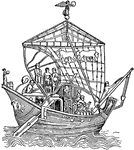
A Roman Freight Ship
"This ship lies besides the wharf at Ostia. In the afterpart of the vessel is a cabin with two windows.…

A Roman Legionary
"From a monument of the imperial age. The soldier wears a metal helmet, a leather doublet with shoulder-pieces,…

A Roman Farmer with a Plow
Illustration of a Roman farmer driving his plow, called an aratrum. The man wears a typical brimmed…

Roman School Materials - Based on a Wall Painting from Pompeii
An illustration of a Pompeiian wall painting of school materials, including scrolls, books, writing…
Roman Siege Works
A Roman Siege Works, with A and B, a double wall; C, C, C, Vineæ; D, an Agger; E, a movable tower;…

Roman Soldiers
The distinction between rank and unit type doesn't seem to have been as precise as in a modern-day army,…

Roman Soldiers and Equipment
"1, funditor; 2, 2, milites levis armaturae; 3, 3, legionarii; 4, sarcina."—D'ooge & Eastman,…

A Roman Standard Bearer
"From a gravestone of the first century A.D. The standard consists of a spear crowned with a wreath,…

A Roman Standard-Bearer called an Aquilifer
Illustration of an aquilifer carrying the eagle standard for his Roman legion. His left hand sits on…

A Roman Temple
"The best preserved of Roman temples. Located at Nimes in southern France, where it is known as La Maison…

Roman Tent
"The Roman soldiers seem to have used two sorts of tents, one, a tent proper, of canvas or some analogous…

Roman Toga - View from the Back
A view of the back of a Roman toga. The man stands with his right foot slightly behind his left, as…

Roman Die
A small cubed marked on its faces with spots numbering from one to six, used in gaming from being thrown…

Castra Romana
"A, via principalis. B, via documana. C, porta praetoria. D, porta decumana. E, portq principalis dextra.…

The Wall of Rome
"Constructed by Aurelian and rebuilt by Honorius. The material is concrete faced with brick; thickness,…
Caesar Crossing the Rubicon
An image of Julius Caesar and his army crossing the Rubicon River, which is located in northeastern…
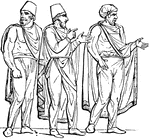
Sagum
"The sagum was open in the front, and usually fastened across the shoulders by a clasp. The form of…






















